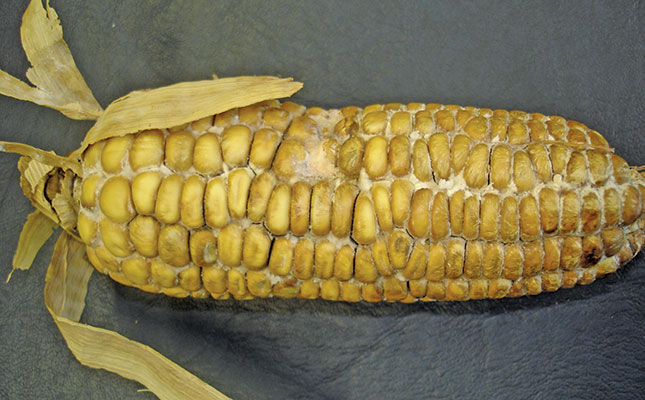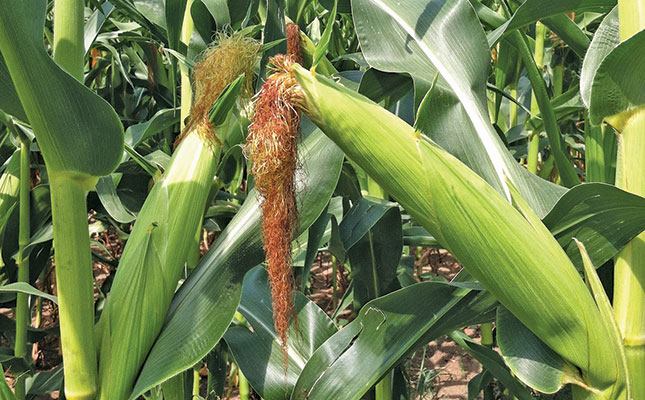Diplodia ear rot, which is caused by the fungus Stenocarpella maydis, occurs worldwide. Drought in the early part of a production season, followed by rain during the late season, create favourable conditions for an epidemic, especially where high inoculum sources are present in the stubble (stover) on the soil.
S. maydis causes hardened, round, black, spore-producing structures. These can overwinter on maize stubble and produce spores in spring. After rain, or during high humidity, the structures release spores into the air; these land on maize plants and infect the base of the ear-leaf junction. The disease then spreads upwards into the ear.
The entire ear becomes filled with a white mycelial growth that affects grain quality. Infected kernels are light in weight and brittle, easily breaking during post-harvest handling, and eventually result in the downgrading of a consignment of maize.
A cross-section of an infected ear shows the black spore-producing bodies at the bases of the kernels. Late-season infection may occur when kernel moisture is low, but the symptoms are less obvious at this stage.
Diplodia ear rot can reoccur in certain areas. Should infected grain be mixed with healthy grain during harvesting, quality will be compromised, leading to a lower price. When early infections are present in an epidemic, yield losses can be of great economic importance.
Diplodiosis
Another serious result of diplodia ear rot is that cattle or sheep that feed on diplodia-infected maize ears can become infected with diplodiosis, a nervous disorder.
Cases of diplodiosis occur from six days to two weeks after the animals are placed on lands with infected maize cobs.

The disease, a mycotoxicosis, is characterised by immovability, a widely based stance, loss of coordination, tremors, paralysis and death. It also causes abnormal foetal development and foetal death.
Field outbreaks of diplodiosis in Southern Africa are favoured by heavy, late rain and occur during the late winter months (July to September). Grazing cattle on maize stover during winter is also a major contributing factor to outbreaks of the disease.
Control of diplodia includes stubble removal, reduction of stress and crop rotation.
Stubble removal
Stubble can be removed through grazing, burning, baling or ploughing-in. Because the fungus thrives on maize stubble and survives poorly in soil, any management practice that decreases the quantity of infected surface stubble will reduce inoculum concentrations on the land.
Be warned: removing stubble for just one season will reduce diplodia only for that season. If the stubble is left on the lands the following season, the risk of diplodia ear rot will increase to its original level, depending on weather conditions.
Stress reduction
Avoid planting unrealistically high plant populations on marginal soils and in areas with a high probability of drought, leaf diseases or other stalk rot diseases. Maize already weakened by stalk and leaf diseases is more susceptible to diplodia.
Ensure adequate and balanced plant nutrition relative to the yield potential of the land or area to be planted.
Unnecessary stressors on the crop may increase inoculum levels on the land. Under conditions favourable for diplodia ear rot, an epidemic may occur.
Because of their relatively intense rotational cropping practices, smallholder farmers generally experience fewer problems with diplodia than commercial producers, who are inclined to monocropping.
Crop rotation
Crop rotation reduces diplodia ear rot by reducing inoculum levels in two ways.
First, a non-host for the fungus prevents the fungus from persisting during the season where maize is not grown.
Second, a greater period (a season or two) between maize crops allows for a natural breakdown of maize stubble, which again reduces the survival of the fungus.
Leguminous crops, such as soya bean, dry beans, groundnuts, and cowpeas, are good rotation crops. Other rotation crops that reduce diplodia ear rot are wheat and oats.
Sunflower has been shown not to reduce diplodia ear rot significantly under experimental conditions; the reason for this is as yet unknown.
Early harvesting
Early harvesting will reduce the occurrence of diplodia ear rot, as it lessens the time available for the fungus to grow on the ear. In contrast, late or winter rain tends to keep the ears wet and increases the chance of fungal growth.
In certain cases, it pays to harvest early at higher moisture levels and to dry the grain artificially. This is possibly why diplodia ear rot is not a major problem in the US, where this practice is followed.
Cultivar selection is also crucial for the control of diplodia ear rot. In general, a resistant hybrid will have less diplodia ear rot than susceptible hybrids relative to prevailing conditions, based on interaction between the available inoculum, the host and prevailing weather conditions.
Most of the many diplodia-resistent maize hybrids react consistently over all the maize production areas, and producers should use these cultivars, suited to the areas in which they farm.



